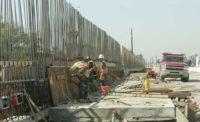So far this year, Bailey says WVDOT hasn’t postponed any projects, “but we’re about a month away from making decisions on what we do on that front, if we don’t see any movement on the extension, or something.”
Nevada DOT Director Rudy Malfabon says his agency hasn’t yet postponed bid lettings, but it has advised the State Transportation Board about the “slate of projects that would be slowed down if we don’t see any relief on funding.” They include highway preservation projects on Interstate 80.
Malfabon also says, “The lack of long-term funding just means that we have to very hesitant to pull the trigger on larger projects.”
For example, near Las Vegas, the state DOT would like to widen the freeway and frontage road and construct bridges over rail tracks. He says, “But if we don’t have the federal funds to do something … of that magnitude, what’s the use of pulling the trigger on something that large if you can’t pay for it?”
Michael T. Tooley, Montana DOT’s director, said his state is “having to come up with contingency plans right now, because the way the federal measure was set up, May 31 is just the start of our construction season and because … we have such as short one we like to try and get 85% of our work out the door in those first couple of months.”
Tooley says his department now is looking at prioritizing projects, to determine “what we can do that the cash will fit—assuming that Congress will do something, like they say they will, by May 31.”
Montana DOT hasn’t postponed bid lettings yet. But Tooley says, “We are looking at the late March lettings for the first potential projects to slip to later months.”
He adds, “We are not going to meet our goal of letting 85% of our work early … May 31 was not a good time to have this issue come up.”
At Colorado DOT, Bhatt says, “We’re evaluating the program right now.” He says the state may let the situation in Washington play out a bit before making decisions, but adds that “there are definitely projects that we will not advertise and we will not let contracts if the funding is not there.”
U.S. DOT Secretary Anthony Foxx, speaking at the AASHTO meeting, continued to push for a major, multi-year authorization. He said, “It needs to be a long-term bill that really meets the need of a growing 21st-century America.”
Foxx told reporters after his speech that another stopgap is “not inevitable.” He added, “When folks’ minds get fixed around a major problem, things can happen very quickly.”
Senate Environment and Public Works Committee Chairman James Inhofe (R-Okla.), who also addressed the state officials’ meeting, said short-term extensions “are not the answer.”
Inhofe, whose committee is responsible for the highway-policy portion of the surface-transportation bill, later told reporters he felt Congress could pass multi-year legislation by May 31. “I know it’s ambitious,” he acknowledged, “but we can do it.”
Inhofe also said that going beyond May for even a month or two would mean moving into the usual period for the construction season, and result in cost increases of 7% or 8%.
House Transportation and Infrastructure Committee Chairman Bill Shuster (R-Pa.), told the attendees, “I’m confident we are going to get a long-term bill” citing bipartisan House and Senate and White House support for that idea.”
He also said he’s working with the Ways and Means Committee daily on the funding issue—“trying to get them a number, trying to push the number up, they may push down.”
Shuster told reporters after his speech, “My goal and my focus is to try to do something on time, in May. I will tell you, though, that every day [and] week that goes by that we don’t have a funding solution, it makes it difficult.”



Post a comment to this article
Report Abusive Comment